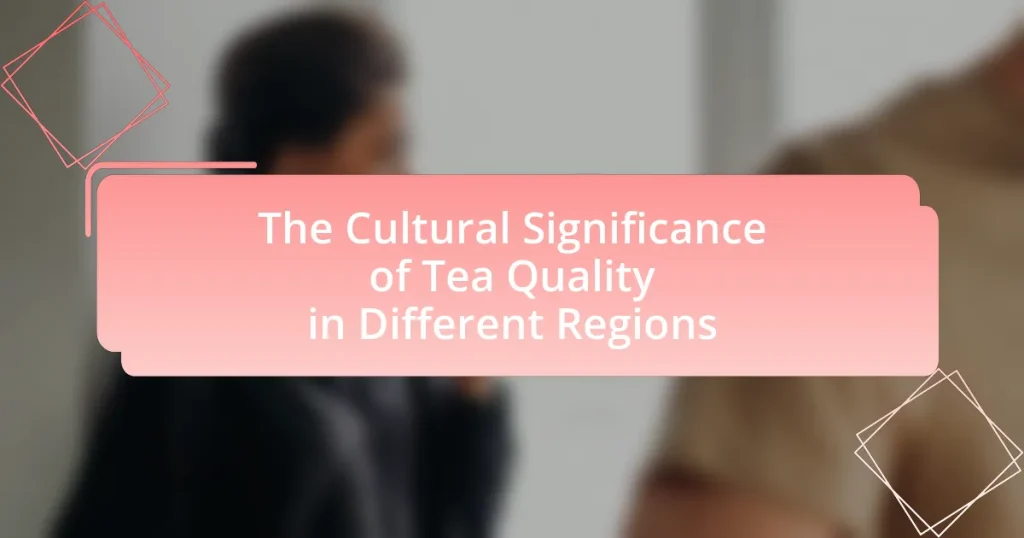The article examines the cultural significance of tea quality across various regions, highlighting how local traditions, social practices, and economic factors shape perceptions of tea. It discusses the role of tea in social rituals, the influence of historical contexts on quality perceptions, and the importance of tea quality in regional identities and economies. Additionally, the article explores how local agriculture, climate change, and globalization affect tea quality, while also identifying best practices for enhancing cultivation techniques. The interplay between consumer preferences and cultural practices in assessing tea quality is also addressed, underscoring the multifaceted nature of tea as both a beverage and a cultural symbol.

What is the Cultural Significance of Tea Quality in Different Regions?
The cultural significance of tea quality varies across different regions, reflecting local traditions, social practices, and economic factors. In countries like China, the quality of tea is deeply intertwined with cultural heritage, where specific varieties such as Longjing and Tieguanyin are celebrated for their unique flavors and historical importance, often associated with traditional ceremonies and social gatherings. In Japan, the quality of matcha is paramount, as it plays a central role in the tea ceremony, symbolizing harmony and respect. In India, particularly in Assam and Darjeeling, high-quality tea is not only a source of national but also a significant economic driver, influencing local livelihoods and cultural identity. These regional distinctions highlight how tea quality serves as a marker of cultural identity, social status, and economic value, reinforcing the beverage’s role in daily life and ceremonial practices.
How does tea quality reflect cultural values in various societies?
Tea quality reflects cultural values in various societies by serving as a symbol of hospitality, social status, and tradition. In countries like China, high-quality tea is associated with respect and honor, often used in ceremonies that emphasize the importance of relationships and social harmony. For instance, the Gongfu tea ceremony highlights meticulous preparation and appreciation of fine tea, showcasing cultural reverence for craftsmanship and patience. Similarly, in Japan, the practice of tea ceremonies, such as Chanoyu, emphasizes aesthetics, mindfulness, and the spiritual connection between host and guest, reinforcing values of simplicity and harmony. In contrast, in British culture, the quality of tea can signify social class, with premium blends often reserved for the upper class, reflecting societal hierarchies. Thus, the quality of tea not only serves as a beverage but also embodies deeper cultural meanings and societal norms across different regions.
What role does tea play in social rituals and traditions?
Tea serves as a central element in various social rituals and traditions across cultures. In countries like China, the tea ceremony emphasizes respect, harmony, and mindfulness, reflecting deep cultural values. Similarly, in Japan, the traditional tea ceremony, known as “chanoyu,” embodies aesthetics and spirituality, showcasing the importance of tea in social gatherings. In Britain, afternoon tea has evolved into a social event that fosters community and conversation, highlighting tea’s role in social bonding. These practices illustrate how tea transcends mere consumption, becoming a medium for cultural expression and social interaction.
How do historical factors influence tea quality perceptions?
Historical factors significantly influence tea quality perceptions by shaping cultural traditions, production methods, and regional reputations. For instance, the long-standing history of tea cultivation in China, dating back over 5,000 years, has established a deep cultural significance and a perception of high quality associated with Chinese teas. Similarly, the British colonial period introduced Indian teas to Western markets, creating a perception of quality linked to the Darjeeling and Assam regions. These historical contexts contribute to consumer expectations and preferences, as evidenced by the premium pricing of teas from regions with rich histories, such as the high demand for Japanese matcha, which is rooted in centuries-old practices.
Why is tea quality important in regional identities?
Tea quality is important in regional identities because it reflects the unique agricultural practices, cultural traditions, and historical significance of a region. High-quality tea often signifies the expertise of local farmers and the specific terroir, which includes soil, climate, and cultivation methods unique to that area. For instance, Darjeeling tea from India is renowned for its distinct flavor profile, which is a result of the region’s altitude and climate, thus contributing to its identity as a premium product. Additionally, tea quality influences local economies and tourism, as regions known for high-quality tea attract visitors seeking authentic experiences. This connection between tea quality and regional identity is further supported by the fact that specific tea varieties are often tied to cultural rituals and social practices, reinforcing the importance of maintaining high standards in production.
How does local agriculture affect tea quality?
Local agriculture significantly affects tea quality through factors such as soil health, climate conditions, and farming practices. The specific nutrients available in the soil, which vary by region, directly influence the flavor profile and chemical composition of tea leaves. For instance, regions with rich, well-drained soils, like those found in Assam, India, produce robust and malty teas due to the high levels of organic matter and minerals. Additionally, local climate conditions, including temperature and rainfall patterns, impact the growth cycle of tea plants, affecting their maturity and flavor. Research indicates that teas grown in optimal conditions, such as those found in the high altitudes of Darjeeling, yield delicate and aromatic flavors, highlighting the importance of local agricultural practices in determining tea quality.
What are the unique characteristics of tea from different regions?
Tea from different regions exhibits unique characteristics influenced by climate, soil, and cultivation methods. For instance, Chinese teas, such as Longjing (Dragon Well), are known for their delicate, sweet flavor and flat, pan-fired leaves, attributed to the region’s specific climate and traditional processing techniques. Indian Assam tea, on the other hand, is characterized by its bold, malty flavor and dark color, resulting from the region’s rich soil and humid climate. Darjeeling tea, often referred to as the “Champagne of teas,” has a floral aroma and muscatel flavor, which is a result of the high-altitude growing conditions and unique processing methods. Japanese green teas, like Matcha, are recognized for their vibrant green color and umami taste, stemming from the shading of tea plants before harvest, which enhances chlorophyll levels. Each of these regional teas reflects the local environment and cultural practices, making them distinct in flavor and quality.
What are the economic implications of tea quality in different cultures?
The economic implications of tea quality in different cultures are significant, as higher quality tea often commands premium prices, influencing local economies and trade dynamics. For instance, in countries like China and Japan, where tea quality is deeply tied to cultural heritage, premium teas such as Longjing and Matcha can sell for hundreds of dollars per kilogram, directly impacting farmers’ incomes and local economies. Conversely, in regions where lower quality tea is produced, such as some parts of India and Africa, the economic benefits are diminished, leading to lower profit margins for producers. This disparity in tea quality affects export revenues, employment opportunities in tea cultivation, and the overall economic stability of tea-producing regions. Additionally, the global demand for high-quality tea has led to increased investment in sustainable farming practices, further influencing economic growth in these cultures.
How does tea quality impact trade and commerce?
Tea quality significantly impacts trade and commerce by influencing market demand, pricing, and consumer preferences. High-quality tea commands higher prices and attracts premium buyers, thereby enhancing profitability for producers and traders. For instance, specialty teas like Darjeeling or Matcha often see increased export value due to their perceived quality and unique characteristics, leading to a more lucrative trade environment. Additionally, the global tea market, valued at approximately $200 billion in 2021, demonstrates that quality differentiation plays a crucial role in shaping trade dynamics, as consumers are willing to pay a premium for superior products.
What are the effects of tea quality on local economies?
Tea quality significantly impacts local economies by influencing market prices, consumer demand, and employment opportunities. High-quality tea often commands higher prices, which can lead to increased income for local farmers and producers. For instance, regions known for premium tea, such as Darjeeling in India, benefit economically as their products attract both domestic and international buyers willing to pay a premium. This demand not only boosts local sales but also encourages investment in better agricultural practices and infrastructure. Furthermore, the tea industry creates jobs in cultivation, processing, and distribution, contributing to overall economic stability in tea-producing areas. According to a study by the International Tea Committee, the global tea market was valued at approximately $200 billion in 2020, highlighting the economic significance of tea quality in driving local economies.
How do cultural practices influence tea quality assessment?
Cultural practices significantly influence tea quality assessment by shaping the criteria and methods used to evaluate tea. In regions like China, traditional practices emphasize sensory evaluation, where aspects such as aroma, flavor, and appearance are meticulously assessed based on centuries-old standards. For instance, the Gongfu tea ceremony highlights the importance of brewing techniques and the tea’s visual presentation, which directly impacts perceived quality. Additionally, cultural beliefs surrounding tea, such as the association of certain varieties with health benefits or social status, further dictate quality perceptions. Research indicates that in Japan, the practice of matcha preparation involves specific rituals that enhance the overall experience and quality assessment, demonstrating how cultural context shapes evaluation criteria.
What methods are used to evaluate tea quality in various cultures?
Various cultures employ distinct methods to evaluate tea quality, including sensory analysis, chemical testing, and traditional practices. In China, for instance, the Gongfu tea ceremony emphasizes sensory evaluation through taste, aroma, and visual inspection of the leaves, reflecting the cultural importance of tea aesthetics. In Japan, the practice of tea tasting, or “sencha,” involves assessing the umami flavor and clarity of the brew, showcasing the significance of flavor profiles in Japanese tea culture. Additionally, in India, tea quality is often judged based on the leaf appearance, aroma, and infusion color, particularly in Assam and Darjeeling regions, where specific grading systems like “FTGFOP” (Finest Tippy Golden Flowery Orange Pekoe) are used to classify tea. These methods highlight the cultural significance and diverse approaches to tea quality evaluation across different regions.
How do consumer preferences shape tea quality standards?
Consumer preferences significantly shape tea quality standards by driving producers to meet specific taste, aroma, and appearance criteria. As consumers increasingly demand high-quality, organic, and sustainably sourced teas, producers adapt their cultivation and processing methods to align with these preferences. For instance, a study by the International Tea Committee indicates that the global market for premium tea has grown by 20% annually, reflecting a shift towards higher quality standards driven by consumer choices. This evolution in consumer demand compels tea producers to enhance their quality control measures and invest in better agricultural practices, ultimately raising the overall quality of tea available in the market.
What are the challenges faced by regions in maintaining tea quality?
Regions face several challenges in maintaining tea quality, including climate variability, pest management, and soil health. Climate variability affects temperature and rainfall patterns, which can lead to inconsistent growth and flavor profiles in tea plants. Pest management is crucial, as infestations can damage crops and reduce quality; for instance, the tea mosquito bug can severely impact yield and flavor. Additionally, soil health is vital for nutrient availability; degraded soil can lead to poor plant health and inferior tea quality. These factors collectively hinder the ability of regions to produce high-quality tea consistently.
How do climate change and environmental factors affect tea quality?
Climate change and environmental factors significantly impact tea quality by altering growth conditions, affecting flavor profiles, and influencing chemical composition. Rising temperatures can lead to increased rates of photosynthesis, which may enhance certain flavor compounds but can also result in a loss of desirable characteristics if conditions become too extreme. Additionally, changes in precipitation patterns can affect soil moisture and nutrient availability, leading to variations in tea leaf quality. Research indicates that specific climate conditions, such as temperature and humidity, are crucial for the development of the unique flavors associated with different tea varieties, as seen in studies conducted by the International Tea Research Institute, which highlight the correlation between climate variables and tea quality metrics.
What are the impacts of globalization on regional tea quality?
Globalization significantly impacts regional tea quality by promoting standardization and increasing competition. As global markets expand, tea producers often prioritize uniformity in flavor and appearance to meet international consumer preferences, which can lead to a decline in the unique characteristics of regional teas. For instance, the rise of large-scale tea plantations in countries like India and Sri Lanka has resulted in the production of mass-market teas that may lack the distinct qualities of traditional, locally grown varieties. Additionally, the introduction of global supply chains can pressure local farmers to adopt practices that prioritize yield over quality, further diminishing the unique attributes of regional teas.
What best practices can be adopted to enhance tea quality in different regions?
To enhance tea quality in different regions, best practices include implementing proper cultivation techniques, optimizing processing methods, and ensuring effective quality control measures. Proper cultivation techniques involve selecting suitable tea varieties for specific climates and soil types, which can significantly impact flavor and aroma. For instance, regions like Darjeeling benefit from high-altitude cultivation, which enhances the tea’s unique characteristics.
Optimizing processing methods, such as withering, rolling, and oxidation, is crucial for developing desired flavor profiles. For example, traditional hand-rolling in regions like Taiwan contributes to the distinct taste of oolong teas.
Effective quality control measures, including regular testing for pesticide residues and adherence to organic farming standards, ensure that the tea produced meets safety and quality benchmarks. Research indicates that regions implementing these practices, such as Japan with its strict quality regulations, consistently produce higher-quality teas recognized globally.
How can local farmers improve tea cultivation techniques?
Local farmers can improve tea cultivation techniques by adopting integrated pest management (IPM) practices, which reduce chemical pesticide use and enhance biodiversity. Implementing IPM allows farmers to monitor pest populations and use biological control methods, such as introducing natural predators, which has been shown to increase crop yields by up to 20% while maintaining environmental health. Additionally, farmers can enhance soil health through organic amendments and cover cropping, which improves nutrient availability and water retention, leading to better tea quality. Research indicates that regions employing these techniques have reported higher tea quality ratings, demonstrating the effectiveness of these methods in improving cultivation practices.
What role do education and training play in promoting tea quality?
Education and training play a crucial role in promoting tea quality by equipping producers with the necessary knowledge and skills to enhance cultivation, processing, and quality control practices. For instance, training programs focused on best agricultural practices can lead to improved soil management and pest control, which directly affect the quality of tea leaves. Research conducted by the International Tea Committee indicates that regions with structured training initiatives, such as those in Japan and Taiwan, consistently produce higher quality teas due to their emphasis on education in both traditional and modern techniques. This correlation between education and quality underscores the importance of continuous learning and adaptation in the tea industry.


